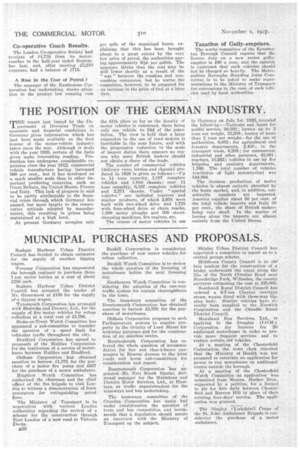THE POSITION OF THE GERMAN INDUSTRY.
Page 38

If you've noticed an error in this article please click here to report it so we can fix it.
THE report just issued by the ,De.partment of Overseas Trade on economic and financial conditions in Germany FiVes information which has just been made available on the first 'census of the motor-vehicle industry taken since the war. Although it deals with the year 1925, certain of the facts given make. interesting reading. ProAuction has undergone considerable ex-pension since the year 1912, commercial vehicle manufacture having increased 560 per cent., but it has developed on a much smaller scale than in other important producing countries, such as Great Britain, the United States, France and Italy. This lack of progress is said to be partly attributable to the financial crisis through which Germany has passed, but more largely to the conservative attitude adopted by manufacturers, this resulting in prices being maintained at a high level. ,
At present Germany occupies only
the fifth place so far as the density of motor vehicles is concerned, there being only one vehicle to 244 of the population. The view is held that a large expansion in the use, of road =Ors is inevitable in the near future, and with the progressive reduction in the scale of import duties there appears no reason why some British makers should not obtain a share of the trade.
• The number if commercial " vehicles (delivery vans, lorries and chassis). produced in 1926 is given as follows :—Up to 1 tons capacity, 3,197 complete vehiclea and 1,010 chassis ; over tons capacity, 6,167. complete vehicles and 2,271 chassis. Under "special vehicles" are included tractors and similar products, of which 24k58 were built with two-wheel drive nnd 1,728 with four-wheel drive or chain tracks, 1.200 motor ploughs and 300 street. cleansing machines, fire engines, etc.
The census of motor vehicles in use in Germany on July 1st, 1926, revealed the following :—Taxicabs and buses for public service,20,392; lorries .up to 2 tons net weight, 33,208; lorries of more than 2 tons net weight—for the use of authorities. 6,082; for agricultural and forestry departments, . 2,430; in the transport trade, 6.208; for commercial, industrial and other purposes, 42,091; tractors, 10,263.; vehicles in use by fire brigades and sanitary departments, 1,769. The total number of vehicles (exclusive of light motorcycles) was 544,894.
The German production of motor vehicles ia almost entirely abaorbed by the home market, and, in addition, considerable numbers are imported. -America supplies about 50 per cent, of the total vehicle imports and Italy 30 per cent.; the share of British makers being very small. In the matter of lorries alone -the imports are almost entirely from the United States.




































































































